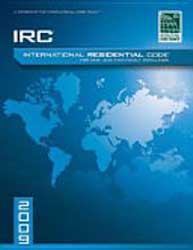 The International Residential Code sets building standards for new home construction in the the US. Some states and counties like California (earthquakes) and Florida (hurricanes) add tougher requirements on top of this code to address issues unique to their locations.
The International Residential Code sets building standards for new home construction in the the US. Some states and counties like California (earthquakes) and Florida (hurricanes) add tougher requirements on top of this code to address issues unique to their locations.
Building codes help insure that our homes are safe, setting guidelines that all builders and remodelers must follow during construction. During new construction and remodeling projects, a building permit must be pulled with your local town describing project scope and projected costs. The town building inspector visits the job site to make sure local building standards are being followed. At the end of the project, the building inspector issues a Certificate of Occupancy (called a CO), that says your home is ready for occupancy.
Building Codes for One and Two Family Homes
The International Residential Code (IRC) is a 700+ page document that combines building, plumbing, mechanical, fuel gas, energy, and electrical provisions into a single resource. This code book applies to one and two family homes and townhouses up to three stories high. The IRC and related building codes are developed by the International Code Council (ICC) involving people actively working in the construction industry. They are then adopted, modified and enforced by local politicians and government agencies, i.e. you town's building department … and they've been adopted by all 50 states and the District of Columbia.
Building codes set minimum standards rather than restrict the design, construction method, materials and products that can be used in building a home. Builders, remodelers and homeowners can work with their local building department to demonstrate that proposed alternatives are equivalent or better than the local building codes.
Builders and remodelers develop a long term relationship with building inspectors who they work with on an ongoing basis. When building a house, I remember talking to my local building department and they asked who my builder was. They know them by name, and they also know and rank them by the quality of their work so I was happy to know I had a “B builder” which meant I would get reasonable quality with paying for a custom home.
Building Codes to Cover What?
When you build a house you tend to focus on the floor plan or what you can see. Building codes cover a lot more than what you see as your electrical wiring, plumbing pipes and more are hidden from sight. Here are the chapters in the IRC that your builder must follow. Don't be surprised if there are more codes for things like energy use, wetlands and oceanfront property, along with condominium regulations.

- Building occupancy classifications
- Building heights and areas
- Interior finishes
- Foundation, wall, and roof construction
- Fire protection systems (sprinkler system requirements and design)
- Materials used in construction
- Elevators and escalators
- Already existing structures
- Means of egress
Most states have one climate zone that influences their building codes although some larger states like Texas have multiple climate zones, each with different energy requirements. You can find your state's energy building code at this IECC Energy Code website. For more information on building codes and who to contact in your state, visit this Building Code Reference Library.
Read Building Codes Set Industry Standards to learn more about the International Building Codes, a series of documents of which the International Residential Code is just one.




Leave a Reply